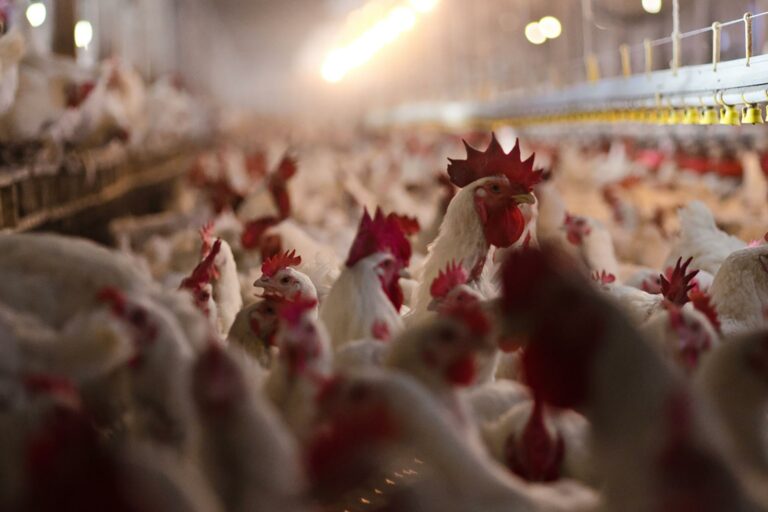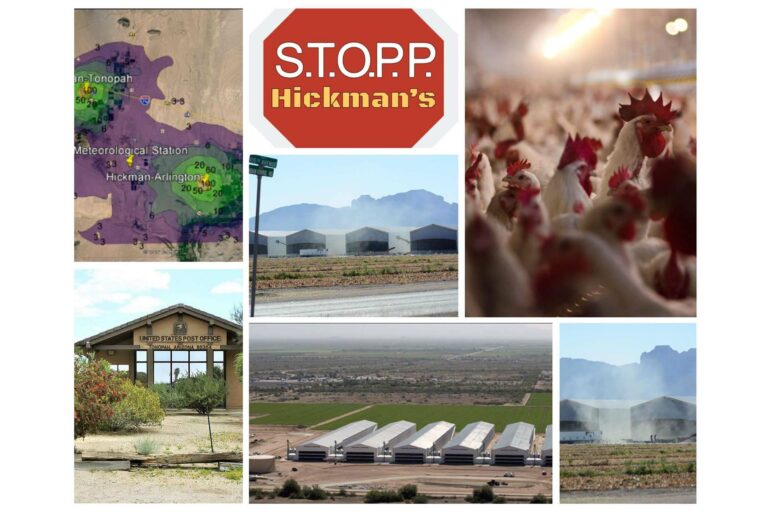At Tonopah Stopp, we’ve long kept a vigilant eye on the Hickmans Egg Factory in Tonopah, Arizona, scrutinizing its operations for the sake of our community’s safety, health, and environment. Recent events across the country have heightened our resolve: hen house fires are striking poultry farms with alarming frequency, leaving millions of animals dead, communities shaken, and questions unanswered. As we monitor our local egg giant, these incidents serve as a stark reminder of the risks industrial-scale poultry farming poses—not just elsewhere, but right here in our backyard.
A National Epidemic of Flames
The past few years have seen a troubling surge in hen house fires, with devastating consequences. Here’s a roundup of some of the most notable incidents:
- San Joaquin Valley, California (2022): A fire ravaged a hen house, claiming the lives of a quarter-million hens in a single night. RFD-TV reported the blaze as a catastrophic loss, yet details on the cause remain scarce.
- Feather Crest Farm, Bryan, Texas (January 2024): A massive fire engulfed this major egg producer, which churns out over 300 million eggs annually. CBS Austin captured the chaos as firefighters battled towering flames, with speculation swirling about the incident’s origins.
- Kurten, Texas (March 2025): Just weeks ago, KXXV News reported multiple fire agencies responding to a blaze at a chicken farm in Kurten. The scale overwhelmed local resources, underscoring the vulnerability of these sprawling facilities.
- Taylorsville, North Carolina (August 28, 2024): The Taylorsville Times detailed a chicken house fire that left a local farm in ruins. While hen losses weren’t specified, the incident mirrors a national pattern.
- South Carolina (2024): WYFF4 covered a fire that gutted a chicken house, raising concerns about the lack of preventive measures in such operations.
- Kansas (Date Unspecified): The Kansan reported a fire that destroyed a “full chicken barn,” leaving the community to grapple with the aftermath.
Video evidence amplifies the horror. Footage from YouTube channels like AgDaily and local news uploads (Minnesota, Indiana, Mississippi, Missouri) show flames tearing through facilities nationwide. A Facebook video from WFLA Beth highlighted the recurring nightmare of “chicken coop fires,” while Wattagnet confirms this isn’t isolated—fires are a persistent plague on U.S. egg production.
Hickmans in the Crosshairs
Closer to home, Hickmans Family Farms has not been immune. On July 27, 2024, a fire ripped through a 700-foot chicken coop at their Tonopah facility, as noted in the Animal Welfare Institute’s (AWI) letter to the NFPA. While exact hen losses weren’t disclosed, the scale suggests a staggering toll. This wasn’t Hickmans’ first brush with disaster—fires in 2019 and 2021 at their Arizona sites killed thousands and 165,000 hens, respectively (CNN, 2021). The AWI flags Hickmans’ Tonopah operation as part of a broader trend, noting that 90% of animal deaths in barn fires since 2013 occurred at large-scale facilities like theirs.
Why does this keep happening? The AWI points to inadequate fire suppression systems, a lack of sprinklers, and the sheer density of animals in these industrial setups. At Hickmans, the question looms: Are they prioritizing profit over safety?
The Cost of Inaction
These fires aren’t just about lost livestock—they’re about lost livelihoods, environmental hazards, and risks to human life. The Feather Crest fire in Texas reportedly caused millions in damages, a figure echoed in a 2022 Pennsylvania blaze that racked up $12 million in losses (Fox43). In rural areas like Tonopah, where fire response times lag due to distance and limited hydrant access, a single spark could spiral into catastrophe. Add the stench of smoke, potential water contamination from runoff, and the emotional toll on nearby residents, and the stakes become clear.
The egg industry often downplays these incidents, arguing that the millions of hens lost are a drop in the bucket compared to annual production. But as the AWI asserts, this logic dismisses the sentient lives at stake and the duty of farm operators to protect them. For Tonopah, it’s personal: Hickmans’ repeated fires suggest a pattern we can’t ignore.
What’s Next for Tonopah?
At Tonopah Stopp, we’re not just sounding the alarm—we’re demanding answers. Why hasn’t Hickmans implemented mandatory sprinkler systems, as proposed in the NFPA 150 code? Why do fire reports remain vague, leaving us to piece together the truth from media scraps? And what’s being done to ensure our community isn’t the next headline?
We call on Hickmans to:
- Install automatic fire sprinklers in all Tonopah facilities, not just new ones.
- Disclose full details of past fire incidents, including causes and losses.
- Work with local fire departments to improve emergency preparedness.
We also urge our fellow citizens to stay vigilant. Share your concerns, attend town meetings, and hold Hickmans accountable. The rash of hen house fires nationwide isn’t a distant problem—it’s a warning. Tonopah deserves better than to be a statistic.
Have tips or firsthand accounts about Hickmans’ operations? Contact Tonopah STOPP. Together, we can keep our community safe.



